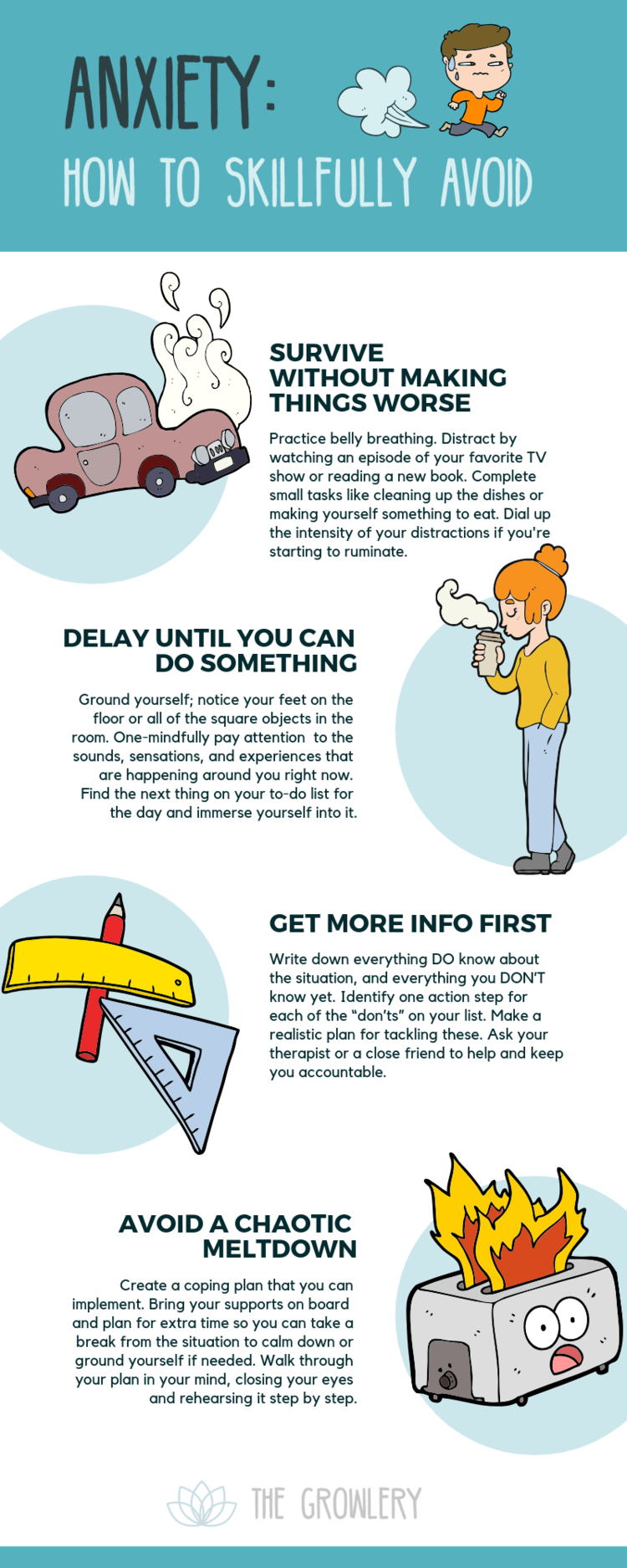Learning to Live With Anxiety - Part Two: How to Skillfully Avoid
When you choose to avoid:
Distract from anxiety and get back to your life
You’re feeling anxious, but you know it’s not the right time to deal with the situation right now. Things are out of your control, there’s nothing you can do, or this is way outside of your comfort zone to handle it alone. You’ve decided to avoid, but…now what? “Hey, anxiety, I decided I’m avoiding you so uhh…bye?” If only we could command our emotions like that :)
Avoiding anxiety can be done with many different coping tools, depending on what’s making you anxious. I’ll give you a run down of a few scenarios where you might choose to avoid, and walk you through options for coping skills.
SCENARIO 1:
YOU CAN’T DO ANYTHING NOW AND JUST NEED TO GET THROUGH YOUR DAY WITHOUT MAKING THING WORSE.
Place your hands on your stomach and take a few slow breaths, filling your belly up with air like a balloon and slowing exhaling through your mouth. Then come up with a short list of coping activities you can do for the rest of the day. Include some distracting things like watching an episode of your favorite TV show or reading a new book, but make sure you also attend to small responsibilities like cleaning up the dishes in your sink and making yourself something to eat. If you notice you start to become overwhelmed and are ruminating about the situation, dial up the intensity of your distraction—find something even more engaging that it’s impossible to do without paying close attention, like frying an egg, completing a word find, playing with your dog (or cat!), or calling a friend to ask about their day.
SCENARIO 2:
THIS ISN’T EVEN ON YOUR MONTHLY TO-DO LIST.
Do some quick grounding to lower your immediate anxiety, then use mindfulness to re-focus on the present moment. Ground yourself by counting the number of square or yellow objects in the room; plant your feet on the floor and notice the sensation your toes feel as they press into your shoes. Make a mental or written note for when you CAN address this issue (maybe your next therapy session), then one-mindfully return to the task at hand. Use mindfulness to pay attention to the sounds, sensations, and experiences that are happening around you right now—what do you see around you? Find the next thing on your to do list for the day and immerse yourself into it, taking a brisk 5-minute walk outside or returning to ground yourself if you notice your mind wandering back towards the anxiety.
SCENARIO 3:
YOU DON’T HAVE ENOUGH INFORMATION TO ACT ON THE SITUATION.
Write down all the things you DO know about the situation, and all of the things you DON’T know yet. Identify one action step for each of the “don’ts” on your list—when can you reasonably accomplish each of these steps? Make a realistic plan for yourself and set a reminder in your phone to check in on your progress in a week. Ask your therapist or a close friend to help you identify the missing pieces if you’re unsure, and keep you accountable for taking steps to gather that info.
SCENARIO 4:
TACKLING THIS WOULD THROW YOU INTO A CHAOTIC MELTDOWN.
Work with your therapist or a trusted friend to create a coping plan that you can implement. Bring your supports on board — is someone willing to be there with you when you have to deal with the situation? Can you schedule a phone call or hang out afterwards? Plan for extra time so you can take a break from the situation to calm down or ground yourself if needed. Walk through your plan in your mind, closing your eyes and rehearsing it step by step.
Continue reading on for Part 3: When you choose to approach: Confront your anxiety without letting it consume you.
Ready to get some personalize help learning how to cope with your anxiety more effectively? Contact us to learn more about starting therapy and take your life back from anxiety.

